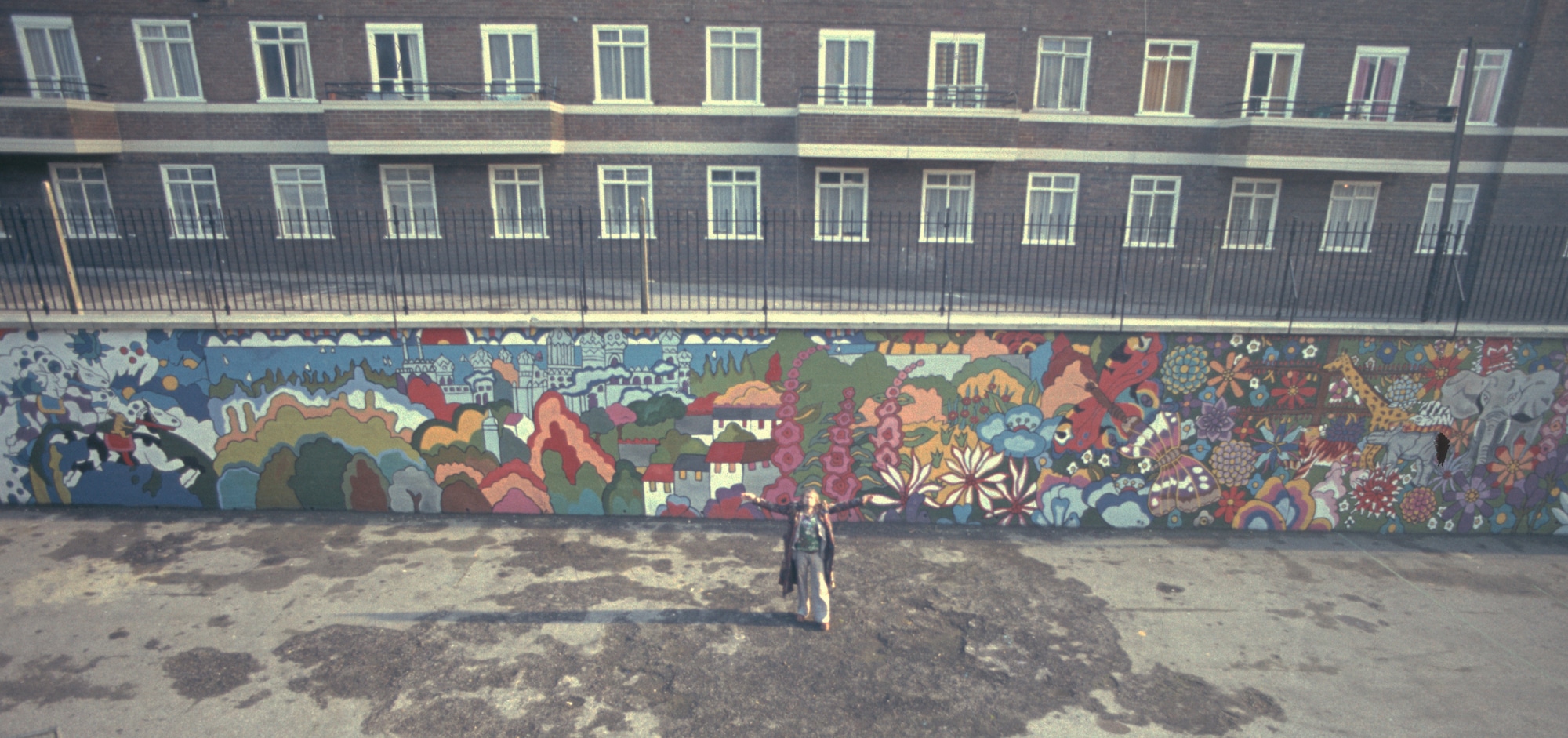John Upton first appeared on the scene in 1965 painting murals in Brighton.
“People were writing poetry that the ordinary public never hear, so I thought I’ll go down Brighton Front and just read something, and gradually it took off. I was painting big pictures on the front and I had fifty or sixty people down there each week- we published magazines and did a touring show, all based on people we met down there,” – and where he got arrested for painting. (There is a photograph: “You can tell it’s 1967, that’s one of my funny suits.”) His scenery for ‘Gargantua’ showing all the organs of the body was thirty feet high. A mural, ‘Let’s make it this summer’ was fifty by sixteen feet – “each summer we work to make the world more ‘It’ – more Ideal.” “Besides Utopia”, he said, “it’s the way I’d like Brighton to be.”
John came from a family of soldiers, father and five brothers all soldiers. He was no good at anything at school, except boxing, “and I was very good”. At seventeen, buoyed by a long run of wins he got a chance to train with his hero – “he was like God” – the British and Commonwealth lightweight champion Thompson. But after the first round, “he didn’t seem to be doing much, and in the second he did even less. I thought he was coasting so I went up to his manager and said, ‘He don’t have to do that you know, I’m better than that.’ And his manager said, ‘What do you mean? Get out.’ and they threw me out. So I said to my manager, ‘What’s the matter?’ and he said, ‘You were better than him.’ But instead of going ‘Wow!’ and it should have led me on – it wasn’t – because he was my hero, it was a loss to me, and I gave up boxing and couldn’t do anything after that.”
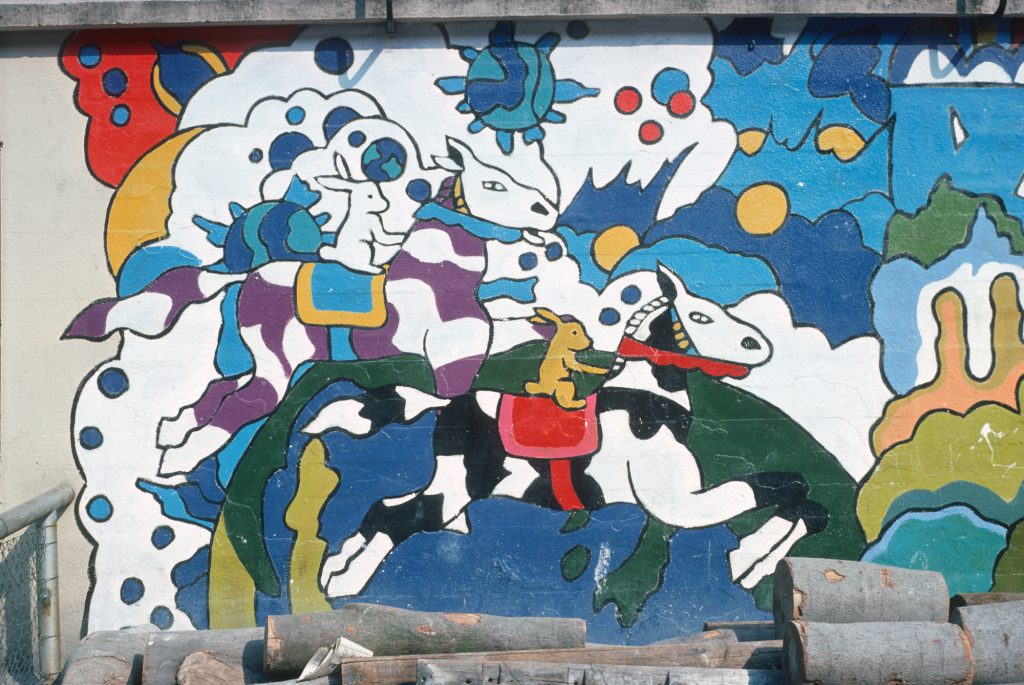
He joined the army, but disillusioned by the regime, went back home. Imprisoned in an army cell awaiting release as a conscientious objector he discovered a book of DH Lawrence poems. “When I got to the bits on flowers I couldn’t believe it! I kept looking at them and thought they’re alive – like I’m alive, and I was really shaken by it. And thought there really is something here, and decided to become an artist; though I didn’t know anything about art and had never drawn anything.” He went abroad to Holland and worked as assistant to a dog portraitist whose wife taught him about Marxism. Back in London he was doing pavement drawing outside the National Gallery “without really knowing there were paintings inside it.” When he went in he discovered Rembrandt, “and that was that!” He read the inventory made upon the artist’s death – “a sad little list” – and reflected on the significance of the total failure of his life. “Yet the ‘Jewish Bride’ left in his studio, kept me awake at night, worrying how good it was.”
John described the influence William Morris’s ‘News From Nowhere’ had on his life. “So knocked out by the passage describing the golden dustman – utopian, something we should aim for, something really good.” He set out to achieve a universal style developed from elements like toy theatre, advertising, comics and postcards, which would be easily recognised and mean something all over the world – flat colours, black lines around the forms. “I’d base my colours on that, but I’d still plan them out like abstracts, and they would have the content that I wanted that people should aim towards. It is the particular set of social ideas which determines the nature of the painting. What the artist does is pick up the vibrations in society and reflects them in his work.”
John made theatre sets and costumes for ‘The Combination Theatre Company’ in Brighton and had painted the pop culture and underground super heroes on the front wall of the Combination School House in West Street. He considered himself an artist who also painted murals as well. He seemed inspired not just by the great Mexican muralists but by DC and Marvel Comics. He had done the stage design for the Combination’s Rasputin Show at The Brighton Combination and The Arts Theatre in London’s West End. When the company moved to ‘The Albany’ in Deptford, Jenny Harris invited him to do a mural on the walls of the Albany on the Creek Road frontage and the Lamerton Street back wall, which he did over the course of the winter of 1971-2.
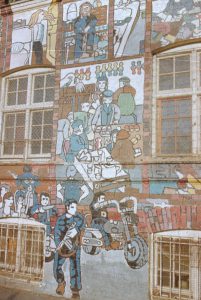 It was a particularly hard winter. He put up an aluminium scaffolding frame and painted an x-ray of what was going on inside the building on the back. In the upper frames he painted the play group and a student hostel room on the fourth floor. On the third floor was the art workshop showing silk screen printing and pottery in progress. He painted Chris Schwarz at his development tank in the dark room. Underneath were the offices of the community workers. The old people of the Darby and Joan Club were seen relaxing in the club room. On the first floor kids and adults drank tea and ate meals in the kitchen run by Mrs Christie. On the ground floor Paul Curno answered a telephone in his office whilst in her adjacent office Sharon Collins worked at the books. In the Combination office Jenny was talking to somebody who could have been an artist or a member of the community. At the door the Combination performers seen as medieval clowns were leaving the building.
It was a particularly hard winter. He put up an aluminium scaffolding frame and painted an x-ray of what was going on inside the building on the back. In the upper frames he painted the play group and a student hostel room on the fourth floor. On the third floor was the art workshop showing silk screen printing and pottery in progress. He painted Chris Schwarz at his development tank in the dark room. Underneath were the offices of the community workers. The old people of the Darby and Joan Club were seen relaxing in the club room. On the first floor kids and adults drank tea and ate meals in the kitchen run by Mrs Christie. On the ground floor Paul Curno answered a telephone in his office whilst in her adjacent office Sharon Collins worked at the books. In the Combination office Jenny was talking to somebody who could have been an artist or a member of the community. At the door the Combination performers seen as medieval clowns were leaving the building.
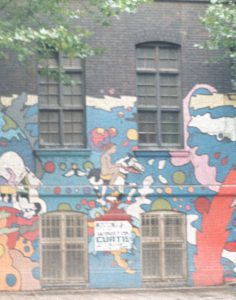
Facing Creek Road, on the front of the building with its barred windows and it’s civic arched double doorway – looking more like a prison than a community centre – a fantasy cosmos exploded across the bottom two stories. A Lady Godiva galloped by on a piebald Totters pony through the planets. A ripped hole in the galaxy exposed a painted red brick wall beneath. Another piebald pony or was it the same? ridden by a Jefferson Airplane white rabbit followed the first in front of a much larger nearer planet. Around one side of the main entrance a yellow fountain that could also have been a cactus plant curved upwards on one side of the door. The foliage came from across the globe. Apart from the cactus there was jungle, woodland and palm trees. The brilliant blue of this outer space universe suggested it could also be underwater.
Above the other side of the door, a sun like a poached egg exploded among a russet and green cloud. Around the main door to what was the Albany Empire, a jungle of wild fruit and animals, snakes, zebras, pandas and deer, winds everywhere. A long haired flautist plays for a skeleton to dance. A Balinese woman in ceremonial dress dances for us. King Kong cradles Fay Ray. A motor cyclist wearing Lincoln Green races through the undergrowth. A dancer appears ready to jump on his pillion seat. A hippopotamus opens its jaws to swallow a window. Beside a first floor window a black woman in a white dress watches us watching this adventure movie. A tiger walks across above the motorcyclist. A giraffe bends it’s neck around the door. Bambi and her mother wait the other side of the door looking patiently at us. On the inside side of the door running up the stairs because they don’t want to miss their cues come the Combination acting group dressed as vagabonds from some intergalactic circus.
Local kids gathered round the scaffolding as John painted through that winter. They wound up depicted in the mural. He fashioned some kind of plastic awning and painted through rain and snow. He started at eight and painted till light faded between three and four. On the scaffolding frame with several layers blurring the edges of his burly middle weight frame, in his paint spattered Jackson Pollock overalls, chuckling at the madness of it all, he himself looked like a demented figure in his own mural. In truth he was as remarkable as his marvellous mural. On the surface he gave us myth on the reverse he gave us the mundane made magical by its ability to see through brick. Both painted with the vivacity of heroic cartoons. That was how he saw the world, like a heroic, sometimes comic, sometimes beautiful, cartoon. Neither front nor back was ever marked with graffiti.
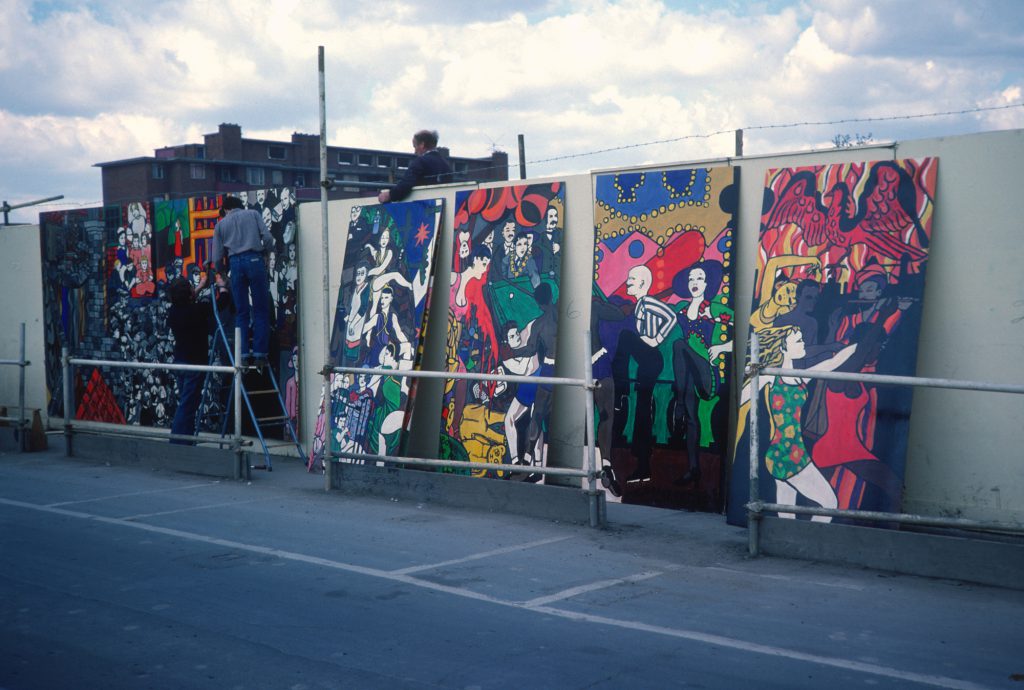
“It is in three parts”, he said, “one, the evils of society, the next, the Albany trying to change it, and Utopia the bit at the end. The dark side in dark colours the good side bright.” He worked with astonishing speed and said, “It’s chance what you grow up to like. You plan it out and it takes time, I work fast and just paint it on. I hire myself out to festivals for three weeks in the year and they expect me to paint at least two murals. I can’t research the whole project, though I do as much as I can; but I have other ways of getting the community involved. As well as a newsletter I ask people to supply paint, even if I don’t use it, because making a contribution helps them to identify with the mural. But speed is just chance: Reubens painted fast – Leonardo never!
John died in 2012.
Essay by Stephen Lobb and John Turner,
